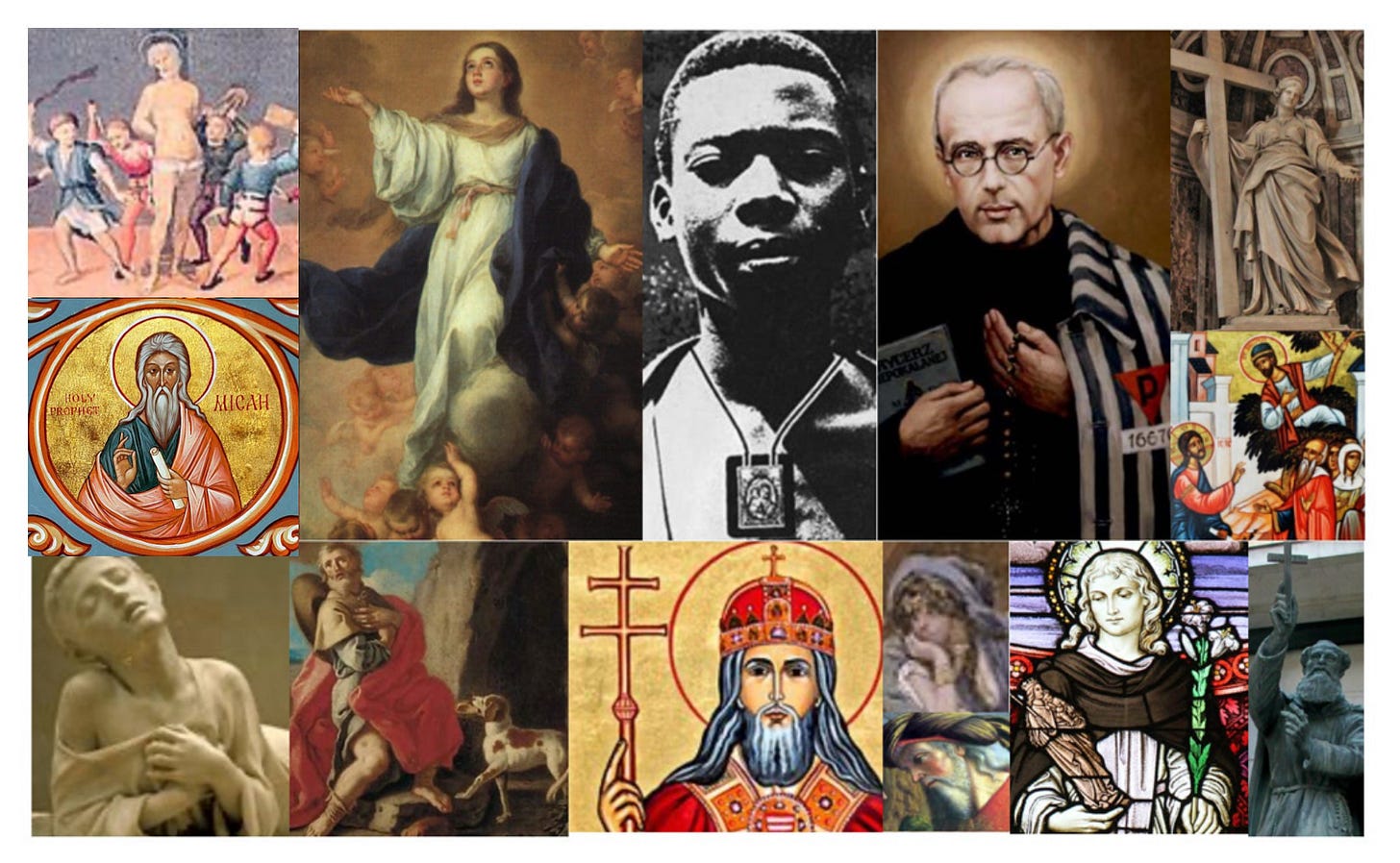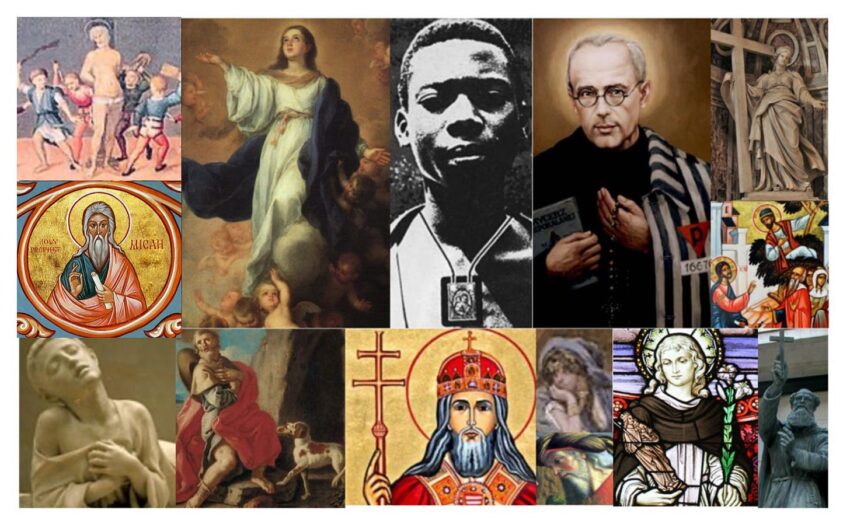
“For behold from henceforth all generations shall call me blessed.” —Mary, Luke 1:48
Aug. 15 was the feast of Mary’s Assumption or Dormition and St. Isidore Bakanja, and you can read my previous article for more details. The Assumption or Dormition of Mary commemorates when Jesus’s Mother “fell asleep” or died and then was by a special grace taken up body and soul into Heaven by her Divine Son. Isidore Bakanja was from the Congo, converted to Christianity by Trappist missionaries. He was zealous to evangelize, carried his Rosary about with him, and wore a scapular around his neck as part of his devotion to Mary. He was violently beaten and abused for this by atheist Belgian colonizers. One atheist in particular wounded Isidore so horribly that it led to his death, after six months of suffering. Isidore died having forgiven his murderer and with his Rosary and scapular on him.
St. Maximilian Kolbe (Aug. 14) is perhaps the most famous martyr of World War II, a Polish Franciscan priest martyred in Auschwitz. He founded the evangelization movement under the patronage of Jesus’s Mother Mary, the Milita Immaculatae, and successfully reached many through his writings and work in Poland and Japan. He was arrested in Feb. 1941 by the Nazis, charged with aiding Jews and the Polish Underground, and ended up in Auschwitz concentration camp. There, “prisoner 16670” did awful and humiliating work, which never killed his charity and priestly zeal, a fact that brought harsh beatings on him from camp guards. In July, a prisoner escaped, and 10 others were to be killed in revenge; one man, Franciszek Gajowniczek, cried out, “My wife! My children!” Kolbe immediately volunteered to take the man’s place and was killed by lethal injection after weeks of starvation and ministering to his fellow victims. Gajowniczek survived the war to spread the story of Kolbe’s heroism and to attend Kolbe’s beatification.
St. Helena (Aug. 18) was the mother of Constantine, the famous Roman emperor who legalized Christianity after his miraculous victory under the standard of the Cross. Helena worked for good her whole life, but she is most famous for leading an expedition to find the True Cross on which Jesus was killed. Finding several crosses on the site, Helena and her companions identified Jesus’s cross by placing a sick woman on each; upon touching the wood of Jesus’s cross, the woman was miraculously healed. St. Daig MacCairaill (Aug. 18) was a bishop, founder of a monastery, and “one of the Three Master Craftsm[e]n of Ireland.”
St. Zacchaeus (Aug. 20) was a despised publican, a dishonest tax collector, when Jesus came to his town. Zacchaeus, being short, climbed a tree to see Jesus, Who stopped and told the publican that He would stay in his house. People murmured at Jesus so honoring a sinner, but Zacchaeus swore, “Behold, Lord, the half of my goods I give to the poor; and if I have wronged any man of any thing, I restore him fourfold.” (Lk. 19:8) Jesus replied, “This day is salvation come to this house, because he also is a son of Abraham.” After Jesus’s death and Resurrection, tradition says Zacchaeus spread the Gospel.
St. Tarcisius (Aug. 15) was a young acolyte “or perhaps a deacon at Rome. He was accosted and beaten to death on the Appian Way by a mob while carrying the Eucharist to some Christians in prison.” Tarcisius died defending the Eucharist. St. Stephen of Hungary (Aug. 16) converted from paganism to Christianity as a child. King of the Hungarian Magyars, he married Bl. Gisela of Ungarn, Emperor St. Henry II’s sister, and fathered St. Emeric. Stephen united the Magyars into one nation. He was an evangelizer who also founded monasteries. St. Roch (Aug. 16), a deeply pious child who grew to be a Franciscan pilgrim, miraculous healer, and a patron saint of dogs who died in unjust imprisonment. Below is a photo I took of his relic in Lisboa.
Sarah the Matriarch (Aug. 19) was the wife of Abraham and the mother of Isaac in her old age. Barren until elderly, Sarah laughed when she heard the Lord tell Abraham she would have a child, and so named her miraculous son Isaac, which means “laughter.” Abraham, Isaac, and Isaac’s son Jacob are the three great founding patriarchs of the Jewish people. We also celebrated the Old Testament Prophet Micah (Aug. 14) this week.
St. Hyacinth (Aug. 17) was Polish, “originally a canon of the Cathedral of Cracow. Having gone to Rome, he became acquainted with St. Dominic and was admitted into the Order of Friars Preachers by the holy Founder himself. He labored for the establishment of the Order in Poland and died in 1257.” He famously saved a large crucifix and a statue of Mary during an attack on the monastery. Hyacinth preached through Poland, Pomerania, Lithuania, Sweden, Norway, Denmark, Scotland, Russia, Turkey, and Greece.
If you enjoy cappuccino, thank Bl. Mark of Aviano (Aug. 13), a Capuchin friar. As a teenager, he set off to preach Christianity and possibly become a martyr in Crete (where Muslim Turks were invading), but was convinced to return home. He became a Capuchin friar and then priest in 1655 in Italy, and after some time living a cloistered life he became a missionary preacher. While preaching at a Paduan monastery, his prayers resulted in the miraculous healing of a bed-ridden religious sister, and Mark soon became famous as a miracle-worker. He became an advisor to the Austrian Emperor and then papal legate for Pope Bl. Innocent XI, whose feast is also this week (Aug. 11). As a spiritual father for the troops liberating Vienna from the Ottoman Turks, Mark was present when the Ottomans fled in such haste they left loads of their bitter coffee behind. The Capuchin Mark mixed the coffee with milk to make it taste better, and the drink was named cappuccino after him.
St. Joachim (Aug. 16, Latin Mass calendar) was the father of the Blessed Virgin Mary and the grandfather of Jesus Christ. Tradition says that he and his wife St. Anne were already old when God blessed them with a daughter, her birth foretold to them in a vision.
Sts. Hippolytus and Cassian (Aug.13): “Hippolytus, guardian of St. Lawrence, was converted and baptized by the Saint. He was tied by the legs to wild horses in 260. St. Cassian, a schoolmaster at Imola, was pierced to death by his pagan pupils, armed with styluses in 320. He is the patron of stenographers.” Bl. Gertrude of Altenberg (Aug. 13) was a nun and the daughter of two other saints—Louis of Thuringia and Elizabeth of Hungary. Sts. Simplician of Milan and Alipius of Tagaste (Aug. 15) were bishops and friends of St. Augustine.
Bl. Jakob Gapp (Aug. 13) was an Austrian priest and anti-Nazi preacher kidnapped and eventually executed by the Nazis. St. Eusebius of Rome (Aug. 14) was a 4th century physician and priest who fought the Arian heresy and died in prison. St. Agapitus the Martyr (Aug. 18) was a third century Roman youth. Bl. Noël-Hilaire Le Conte (Aug. 17) was a priest and one of the Martyrs of the Hulks of Rochefort during the French Revolution. St. Serena (Aug. 16) was the Christian wife of the cruel, pagan Roman Emperor Diocletian.
Also commemorated were Bl. Thomas, Maria, and Jacob Gengoro (Aug. 16), martyrs in 17th century Japan; St. John Eudes (Aug. 19), a French priest, preacher, writer, and founder of religious orders; the 802 Martyrs of Otranto(Aug. 14), killed by Ottoman Muslims in the 1400s; Bl. David Roldan-Lara and other martyrs of the Mexican Revolution (Aug. 15); St. Jeroen van Noordwijk (Aug. 17), a Scottish noble and missionary to the Netherlands martyred by Vikings; St. Jordan of Pisa (Aug. 19), a zealous Italian Dominican preacher; St. Mamas (Aug. 17), a Roman martyr who tamed the lions meant to kill him; St. Beatrice da Silva Meneses (Aug. 17), Portuguese founder of the Congregation of the Immaculate Conception of the Blessed Virgin Mary; and Bl. Teofilius Matulionis (Aug. 20), a Lithuanian archbishop imprisoned, persecuted, and exiled by the Soviets.
Other saints from this week include Maximus the Confessor, John Berchmans, and Queen Radegunde (Aug. 13), Stanislaw Kostka (Aug. 15); Enrique Garcia Beltran (Aug. 16); Pope Eusebius, Nicolò Politi, Clare of Montefalco, and Michaël Kurobyoie (Aug. 17); Macarius the Wonder-Worker and Florus and Laurus (Aug. 18); Sebald, Pope Sixtus III, Martyrs of Nagasaki, Gregorio Martos Muñoz, andAndrew Stratelates and soldiers (Aug. 19); and Oswine of Deira, Philibert of Jumièges, Maria de Mattias, and Heliodorus of Persia and companions (Aug. 20).
Have a blessed week!
Click this link for the original source of this article.
Author: Catherine Salgado
This content is courtesy of, and owned and copyrighted by, https://catherinesalgado.substack.com and its author. This content is made available by use of the public RSS feed offered by the host site and is used for educational purposes only. If you are the author or represent the host site and would like this content removed now and in the future, please contact USSANews.com using the email address in the Contact page found in the website menu.









